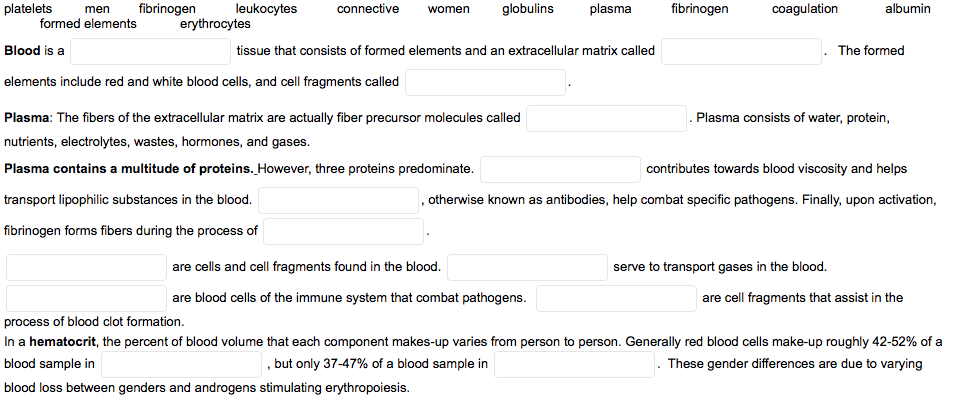platelets formed elements fibrinogen erythrocytes globulins leukocytes connective plasma fibrinogen coagulation albumin men women Blood is a tissue that consists of formed elements and an extracellular matrix called The formed elements include red and white blood cells, and cell fragments called Plasma: The fibers of the extracellular matrix are actually fiber precursor molecules called Plasma consists of water, protein, nutrients, electrolytes, wastes, hormones, and gases. Plasma contains a multitude of proteins. However, three proteins predominate. contributes towards blood viscosity and helps transport lipophilic substances in the blood. , otherwise known as antibodies, help combat specific pathogens. Finally, upon activation, fibrinogen forms fibers during the process of are cells and cell fragments found in the blood. serve to transport gases in the blood. are blood cells of the immune system that combat pathogens. are cell fragments that assist in the process of blood clot formation. In a hematocrit, the percent of blood volume that each component makes-up varies from person to person. Generally red blood cells make-up roughly 42-52% of a blood sample in , but only 37-47% of a blood sample in These gender differences are due to varying blood loss between genders and androgens stimulating erythropoiesis.
Proteins
We generally tend to think of proteins only from a dietary lens, as a component of what we eat. However, they are among the most important and abundant organic macromolecules in the human body, with diverse structures and functions. Every cell contains thousands and thousands of proteins, each with specific functions. Some help in the formation of cellular membrane or walls, some help the cell to move, others act as messages or signals and flow seamlessly from one cell to another, carrying information.
Protein Expression
The method by which living organisms synthesize proteins and further modify and regulate them is called protein expression. Protein expression plays a significant role in several types of research and is highly utilized in molecular biology, biochemistry, and protein research laboratories.

Trending now
This is a popular solution!
Step by step
Solved in 2 steps






